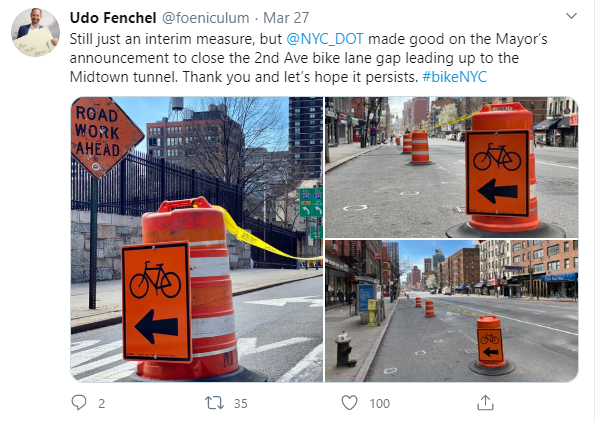Published on:
NYC DOT to add temporary bike paths in effort to reduce bicycle accidents
 After a rise of almost 50% of injuries caused by bicycle accidents in New York City between March 2nd and March 9, the New York DOT created two temporary bike lanes in Manhattan and in Brooklyn. The new bike lanes have been installed in the East of Manhattan and the South of Brooklyn where many of the accidents reported at the beginning of this month occurred.
After a rise of almost 50% of injuries caused by bicycle accidents in New York City between March 2nd and March 9, the New York DOT created two temporary bike lanes in Manhattan and in Brooklyn. The new bike lanes have been installed in the East of Manhattan and the South of Brooklyn where many of the accidents reported at the beginning of this month occurred.The creation of the temporary bike lines takes place at a time during which the Covid-19 crisis has lead to a significant decrease in car traffic and a boom in bike traffic
Between March 1st and March 11, CitiBike rides increased by 67% compared to the same period the previous year with a total of 517,768 trips compared to 310,132. The bike traffic increased significantly on the four bridges connecting Manhattan with Brooklyn and Queens. The New York Times reports that on March 9, 21,300 bike crossings were reported in one day compared to 14,032 a year before, a 52% increase. The increase in bike traffic resulted in an increase of bicycle accidents injuries all over the city (see previous blog) with many of them occurring near bridge crossings.
Second Avenue in Midtown Manhattan and Smith Street in Brooklyn
To prevent these accidents, the DOT installed one protected bike lane along Second Avenue near the Queens Midtown Tunnel and one on Smith Street in Brooklyn. New barrels and signage are physically separating cyclists from cars. More temporary bike lanes should be added soon according to the mayor.
In Queens, Council Member Costa Constantin send a letter to the DOT asking the agency to consider temporary bike lanes in Western Queens on the route that links Northern Astoria to the Queens borough bridge.
Many front line workers who live in Queens and in Brooklyn and do not have a car have switched their mode of transportation from subway to bicycle. These workers need to be able to access their job in a safe an effective manner.
Read more in Streetblog
 New York Personal Injury Attorneys Blog
New York Personal Injury Attorneys Blog


